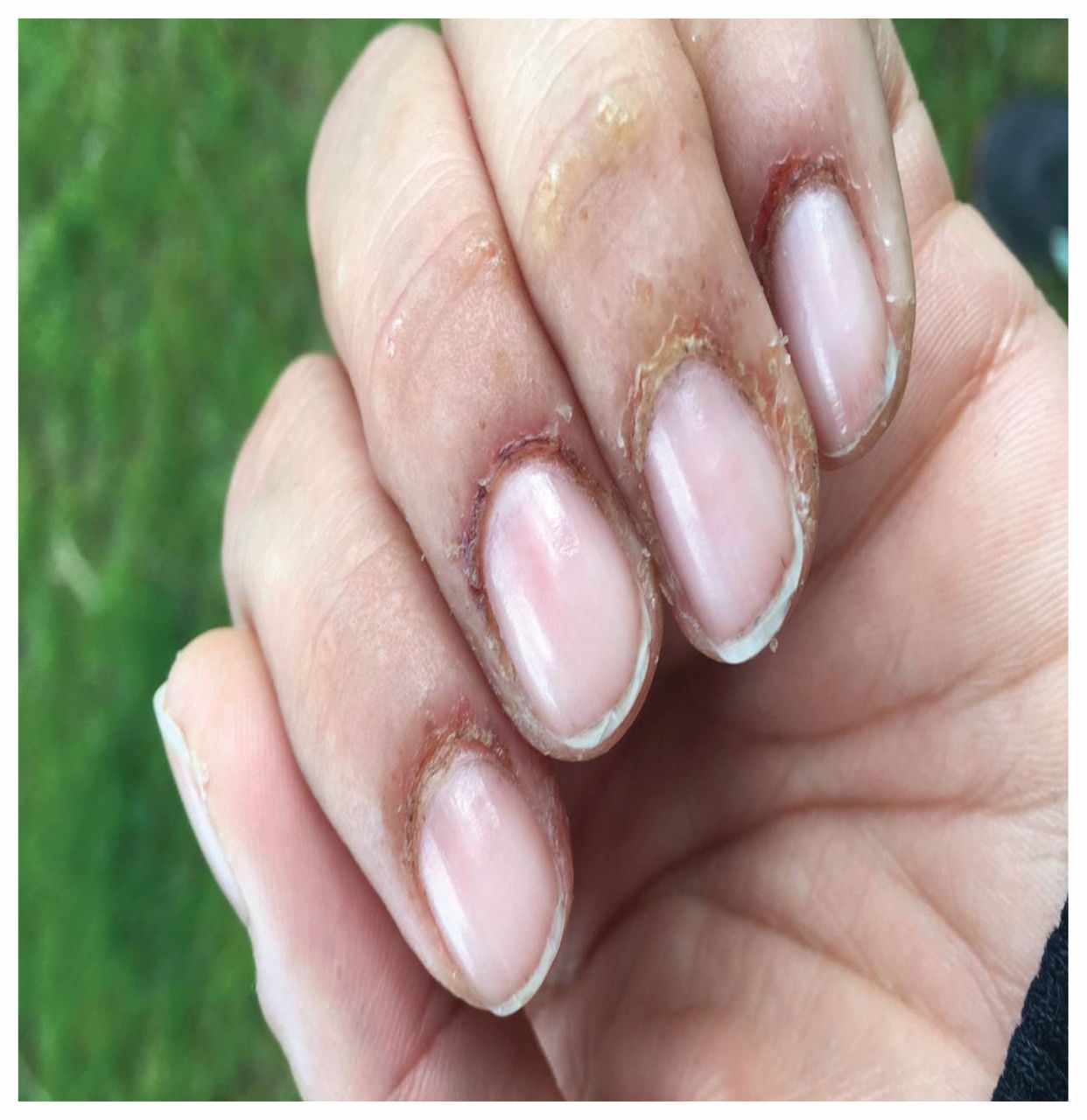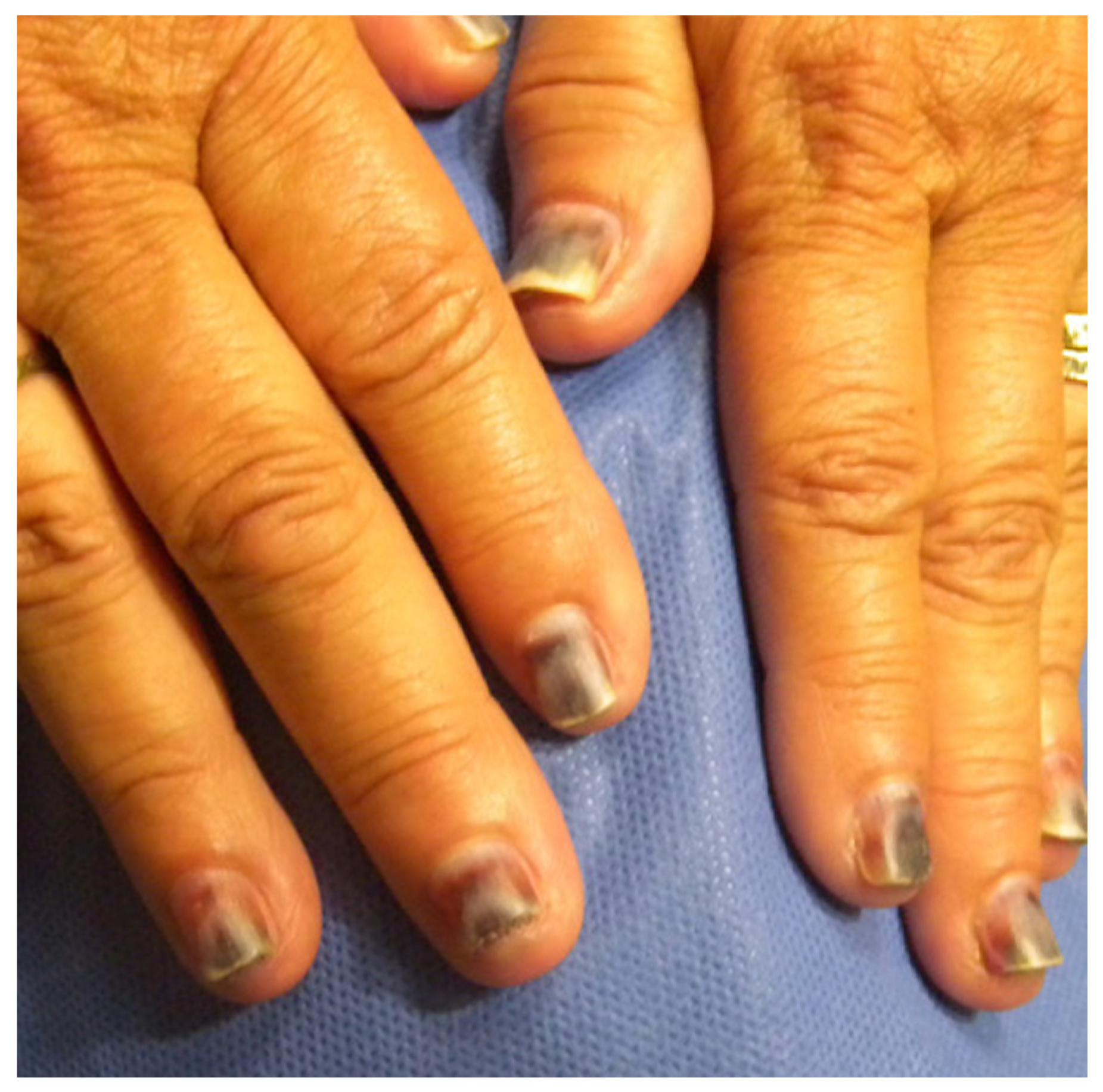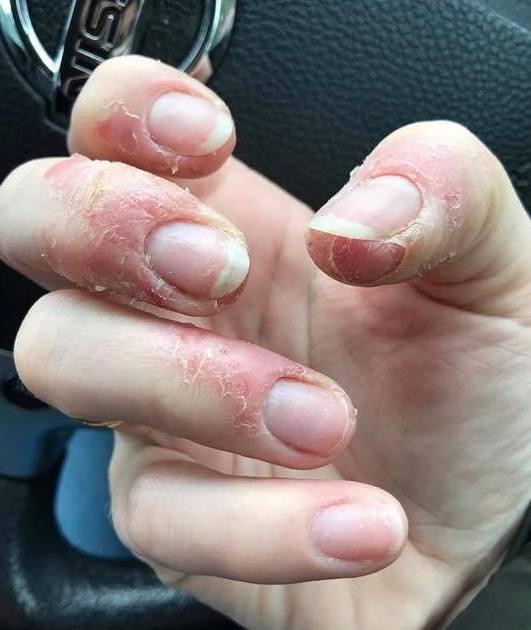Nail Contact Dermatitis: Causes & Treatments | Your Guide
Are your perfectly manicured nails potentially harboring a hidden threat? Allergic contact dermatitis (ACD), triggered by the very products designed to enhance our appearance, is a surprisingly prevalent issue, affecting both professionals and enthusiasts alike.
The world of beauty and personal care often presents a dichotomy: products that promise aesthetic enhancement can simultaneously pose risks to our health. The focus here is on the delicate balance between looking good and staying healthy, particularly as it pertains to the realm of nail cosmetics. While the allure of expertly crafted nails is undeniable, the potential for adverse reactions, specifically allergic contact dermatitis (ACD), cannot be ignored.
The prevalence of ACD related to nail products, including artificial nails, nail polish, and associated chemicals, has been a growing concern. Methacrylates, commonly found in nail products, are frequently identified as key culprits, leading to a range of skin reactions. The issue isn't confined to the consumer; nail technicians and stylists are particularly vulnerable, due to their prolonged and intimate exposure to these substances.
- Emily Mae Young Step By Step Star Welchs Girl Where Is She Now
- Milan Mirabella Latest Leaks Content Whats Trending Now
Research indicates that in the past few years, despite the increased use of artificial nails, the frequency of contact allergy related to these products was still relatively low. But it is always good to take precautions. A study by the North American Contact Dermatitis Group (NACDG) identified tosylamide formaldehyde resin, a component found in many nail polishes, as a significant allergen. This underscores the need for awareness and vigilance in the selection and use of nail products.
Understanding the specific chemicals involved is a critical step in prevention. Tosylamide formaldehyde resin, often listed on product labels, is a prime example. Moreover, the environment of a nail salon can amplify the risks, with airborne particles from nail products leading to increased exposure. Therefore, the professional setting demands extra care and adherence to safety protocols.
The symptoms of ACD can vary, but often include redness, itching, swelling, and even blistering around the nails and surrounding skin. These reactions are the bodys response to an allergen or irritant, and they can be triggered by a variety of substances found in nail products, like acrylics, polishes, and removers. In severe cases, ACD can lead to nail plate abnormalities, such as changes in texture, discoloration, and even the separation of the nail from the nail bed.
The condition presents a challenge. Early recognition of ACD symptoms is crucial. Identifying the specific allergen can be a complex process, often requiring patch testing by a dermatologist. Once identified, avoidance of the offending substance is the cornerstone of management. For those with persistent or severe ACD, it's necessary to consult with a healthcare professional for appropriate treatment, which may involve topical or systemic medications.
The history of ACD in the context of nail cosmetics has evolved since the first reported case in 1956. Over time, there has been a shift in the types of products used and the chemicals they contain. This has led to changes in the prevalence and types of allergic reactions observed. Advances in product formulation and consumer awareness have also played a role in managing and mitigating the risks associated with nail products. Understanding this evolution is essential for both consumers and professionals.
The impact extends beyond the physical symptoms. Individuals with ACD may experience psychological distress due to the visible skin changes. Nail professionals, in particular, may face occupational challenges if their work environment contributes to or exacerbates their condition. There's a growing awareness of the importance of workplace safety, including the use of protective measures like gloves and ventilation to reduce exposure.
The use of artificial nails and nail enhancements has surged. But with this trend comes a corresponding increase in the incidence of ACD. It has brought the need for informed choices and the importance of choosing products with safer formulations. Manufacturers are increasingly responding to consumer demand by offering products that are free from certain allergens, and offering alternatives to the ingredients commonly associated with ACD.
Preventive measures are the first line of defense. This includes reading product labels carefully, avoiding products with known allergens, and practicing proper hygiene. Nail technicians can protect themselves by wearing gloves, working in well-ventilated areas, and using products that are less likely to trigger reactions. Consumers can educate themselves about the ingredients in nail products and look for safer alternatives.
The future of nail cosmetics hinges on innovation and a commitment to safety. The rise of "gel" and other nail enhancements requires ongoing evaluation to ensure they meet safety standards. The development of more hypoallergenic products is a key goal. Ongoing research will continue to refine our understanding of the causes and treatments for ACD, ensuring that beauty and health can coexist harmoniously.
Consider the case of a nail technician who consistently applied acrylic nails. Over time, she began to develop a persistent rash around her nails and on her fingertips. After visiting a dermatologist, she was diagnosed with ACD caused by the methacrylates in the acrylic products. In another example, a consumer reported a severe allergic reaction following a gel manicure. These real-world cases highlight the importance of being vigilant, knowing the risks, and consulting with healthcare professionals if necessary.
The professional environment also presents challenges. Nail technicians, or nail stylists, as they are often called, are particularly susceptible. Their hands are in direct contact with the products throughout the day. Theyre exposed to airborne particles, and the frequency of exposure increases the risk of developing sensitization. These are serious and costly situations that can put an end to anyones career and also have a negative impact on the consumers as well. Occupational acd is possible in this work.
In certain situations, medical attention is necessary. If you suspect an allergic reaction, seek advice immediately. While its crucial for consumers and professionals to understand the risks, dermatologists and other healthcare providers are on the frontline, providing patch testing, diagnosis, and treatment. Their expertise is vital to both prevention and care.
The most common symptom of the condition is contact dermatitis. This is an itchy, swollen rash that is caused by a reaction to an allergen in the environment. Those who work with the products, as well as the consumers themselves, can suffer. Contact dermatitis can be red and itchy. The condition can be caused by your skin's reaction to an allergen or irritant in your environment.
The challenges of managing ACD in the context of nail cosmetics are complex. It requires a multifaceted approach that involves understanding the science behind allergic reactions, being informed about product ingredients, and following safety protocols. Nail professionals play a pivotal role in preventing ACD. They should receive specific training on identifying potential allergens, implementing safety precautions, and educating clients about risks. Both professionals and consumers should adopt a proactive approach and take the necessary precautions.
The development of nail products with an emphasis on safety and hypoallergenic ingredients is a crucial step. The industrys response to the rising incidence of ACD. There is an increased demand for products that are free from common allergens. Also, its important for the manufacturers to follow the ongoing research into causes and treatments.
Alternatives for the 2007 North American Contact Dermatitis Group (NACDG) standard screening tray can be considered. The tray is a test that can be performed to check the reaction to certain products. There are many options that can be explored. The goal is to strike a balance between the creation of aesthetically pleasing nails and the protection of the health of both clients and professionals. This is a delicate balance, but it is essential in the industry.
The rising trend of ACD in acrylic nail products. This is a trend that should be monitored. The goal is to continue improving the safety standards of these types of products. Consumers and professionals should also stay informed to keep their bodies safe and healthy. By prioritizing safety, innovation, and awareness, it is possible to reduce the risks and maintain the benefits that nail cosmetics provide.
Contact dermatitis of the nail unit may be either irritant or allergic, and allergic contact dermatitis (ACD) comprises 20% of contact dermatitis cases of the nail. The nail unit consists of various parts. These may include the proximal nail fold (PNF) and the hyponychium. ACD of the nail apparatus commonly involves the proximal nail fold (pnf) and the hyponychium, and may cause both skin changes and nail plate abnormalities. As a result, its important to be aware of these possibilities.
Nail eczema and nail psoriasis are similar. Both conditions can cause pitting in the nails. Nail psoriasis also causes lifting and white discoloration in the nails. While nail eczema can appear at any age, nail psoriasis typically shows up in older adults. It is important to recognize that there are many conditions that are similar. Therefore, understanding how to distinguish between them is essential.
Another report from 2017 highlighted a specific case of contact dermatitis caused by methacrylate contact dermatitis from shellac nail polish, owned and developed by the nail brand CND. The report helps to inform everyone about the potential for harm that these products can cause. Also, it brings awareness to the need to know about the specific ingredients in these products. As a result, it can help nail technicians and consumers make educated choices.
The chemical most responsible for allergic reactions to nail enamel is tosylamide formaldehyde resin. It is sometimes also called toluenesulfonamide formaldehyde resin. In a study by the North American Contact Dermatitis Group (NACDG), tosylamide formaldehyde resin was found to be the seventh most common ingredient causing allergic contact dermatitis in patients with a cosmetic allergy. These facts reinforce the need to understand what products are being used on the nails. Awareness is a key component of helping those affected by nail allergies.
Contact dermatitis is a red, itchy rash caused by direct contact with a substance or an allergic reaction to it, according to 9, 10 both consumers and professional nail technicians (nail stylists) may be affected, causing occupational ACD in. This reminds everyone that it is possible for both consumers and nail professionals to be affected by this condition. Moreover, the work that nail stylists do is at risk because of this condition. Occupational ACD is a serious matter.
The following table provides a summary of key points related to allergic contact dermatitis (ACD) in nail cosmetics:
| Aspect | Details |
|---|---|
| Definition | An allergic reaction of the skin to substances found in nail products. |
| Common Causes | Methacrylates, tosylamide formaldehyde resin, and other chemicals in nail polish, acrylics, and removers. |
| Affected Groups | Consumers, nail technicians (stylists), and other professionals. |
| Symptoms | Redness, itching, swelling, blistering, and nail plate abnormalities. |
| Diagnosis | Patch testing by a dermatologist. |
| Treatment | Avoidance of allergens, topical or systemic medications. |
| Prevention | Reading product labels, choosing hypoallergenic products, proper hygiene, and workplace safety measures. |
| Nail Unit Involvement | ACD often affects the proximal nail fold and hyponychium, leading to both skin changes and nail plate abnormalities. |
| Industry Response | Development of safer formulations, more hypoallergenic products, and greater awareness of ingredients. |
| Future Trends | Increased focus on innovation, safety standards, and consumer education. |
The rising trend in allergic contact dermatitis to acrylic nail products is concerning, and as a result, the need for the nail industry to respond to this trend is vital. The aim is to continue to improve the safety standards. The goal is to help consumers and professionals stay informed to keep their bodies safe and healthy.
- Unveiling The World Of Nikki Park Wesley Snipes A Deep Dive
- Sarah Jo Pender Wrongfully Convicted Students Prosecutor Speak Out

Contact dermatitis caused by methacrylates in nail products CMAJ

Allergies Free Full Text Contact Dermatitis in Nail Cosmetics

Dermatitis NailKnowledge